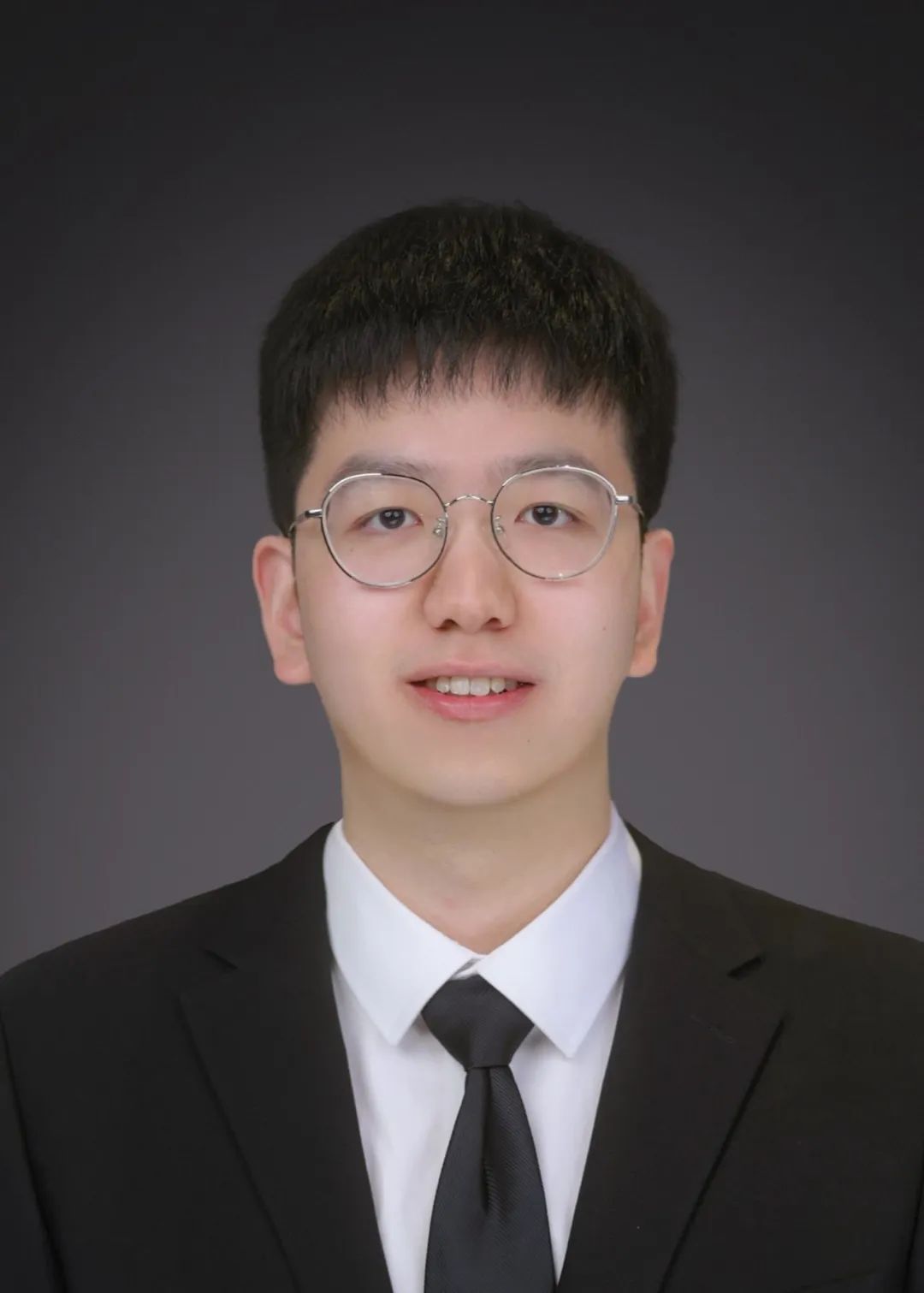Skip to content
With climate change and population growth, the imbalance between the supply and demand of water and food resources is becoming increasingly severe. Especially in urban areas, the demand for water and food resources is particularly urgent. Traditional reliance on supply chain delivery of food and pipeline transportation of water not only leads to high carbon emissions and energy consumption, but also increases the security risks of supplying essential human needs due to long supply chains. The integration of existing building facilities such as rooftop agriculture and heat pump air conditioning with new technologies like radiative cooling, atmospheric water harvesting, and colored photovoltaics has broad prospects for promoting urban safety and sustainable development. The research team published a perspective article in 2023 (doi.org/10.1016/j.energy.2023.129009) exploring various possibilities and potential of the integration of the aforementioned technologies.
To promote the practical implementation of the coupling of atmospheric water harvesting and rooftop agriculture, Professor Wang Ruzhu from Shanghai Jiao Tong University leads the “Energy-Air-Water” interdisciplinary innovation team ITEWA (Innovation Team for Energy, Water & Air) in collaboration with Professor Swee Ching Tan’s team from the National University of Singapore, proposing a new method that integrates waste heat and solar energy-driven atmospheric water harvesting technology with precise rooftop agriculture. They optimized materials and engineering across disciplines based on the dynamic characteristics of materials, climatic features of deployment locations, and plant growth characteristics, and created a fully automated atmospheric water source irrigation rooftop farm. Ultimately, without the need for external water input, the system achieved a water yield of 879.9 g/m² and a food yield of 1.28 kg/m² within 14 days.This provides a new route for achieving distributed co-harvesting of food and water in urban areas and for sustainable urban development. The research results were published in an article titled “Integrating Rooftop Agriculture and Atmospheric Water Harvesting for Water-Food Production Based on Hygroscopic Manganese Complex” in Advanced Functional Materials. The first author of the paper is Shan Xuan, a jointly trained PhD student from Shanghai Jiao Tong University and the National University of Singapore, with Professor Wang Ruzhu and Professor Tan Swee Ching as corresponding authors.
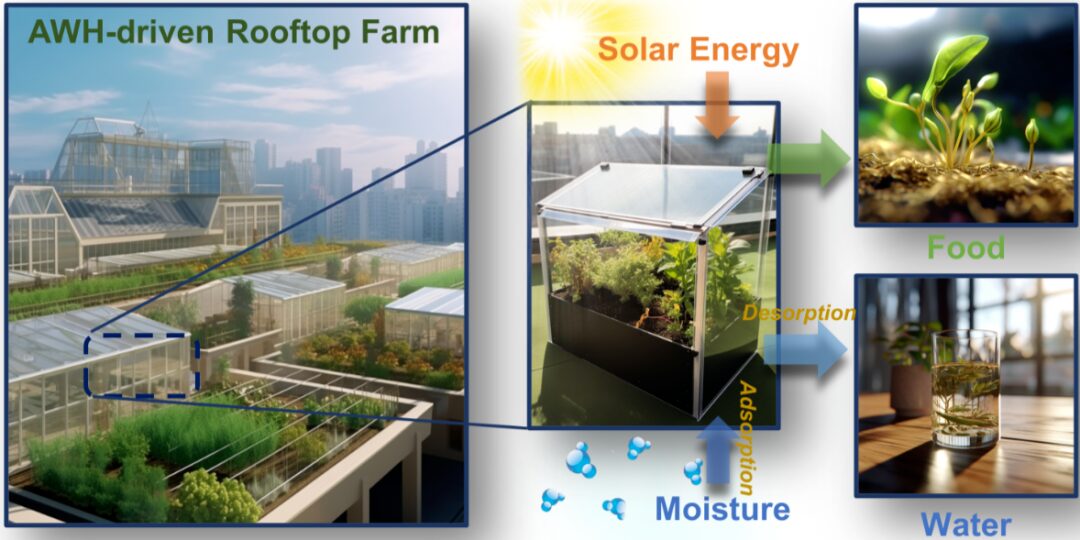 【Laboratory Design and Performance of Hygroscopic Composite Materials】
Targeting large-scale low-cost preparation and rapid kinetics design under medium to high humidity, the research team developed an adsorption material composed of manganese (II)-ethanolamine complex hygroscopic composite and porous polyvinyl alcohol acetal foam matrix. The manganese (II)-ethanolamine complex hygroscopic composite is compatible with biological growth and has lower cost and higher adsorption capacity compared to other complexable transition metal elements. The presence of ultra-large open pore channels and small wall channels in the polyvinyl alcohol acetal foam weakens the internal diffusion resistance of the material, facilitating the transport and adsorption of water vapor. Ultimately, the composite material achieved an adsorption capacity of 0.45-2.54 g g-1 at 50-90% relative humidity, with a leap in water adsorption capacity under medium to high humidity, making it suitable for arid regions with significant day-night temperature differences or semi-humid areas with high humidity throughout the day. Furthermore, the material’s adsorption kinetics reached 0.0235 g g-1 min-1, and the adsorption equilibrium can be completed within 240 minutes, making it suitable for multiple adsorption-desorption cycles.
【Laboratory Design and Performance of Hygroscopic Composite Materials】
Targeting large-scale low-cost preparation and rapid kinetics design under medium to high humidity, the research team developed an adsorption material composed of manganese (II)-ethanolamine complex hygroscopic composite and porous polyvinyl alcohol acetal foam matrix. The manganese (II)-ethanolamine complex hygroscopic composite is compatible with biological growth and has lower cost and higher adsorption capacity compared to other complexable transition metal elements. The presence of ultra-large open pore channels and small wall channels in the polyvinyl alcohol acetal foam weakens the internal diffusion resistance of the material, facilitating the transport and adsorption of water vapor. Ultimately, the composite material achieved an adsorption capacity of 0.45-2.54 g g-1 at 50-90% relative humidity, with a leap in water adsorption capacity under medium to high humidity, making it suitable for arid regions with significant day-night temperature differences or semi-humid areas with high humidity throughout the day. Furthermore, the material’s adsorption kinetics reached 0.0235 g g-1 min-1, and the adsorption equilibrium can be completed within 240 minutes, making it suitable for multiple adsorption-desorption cycles.
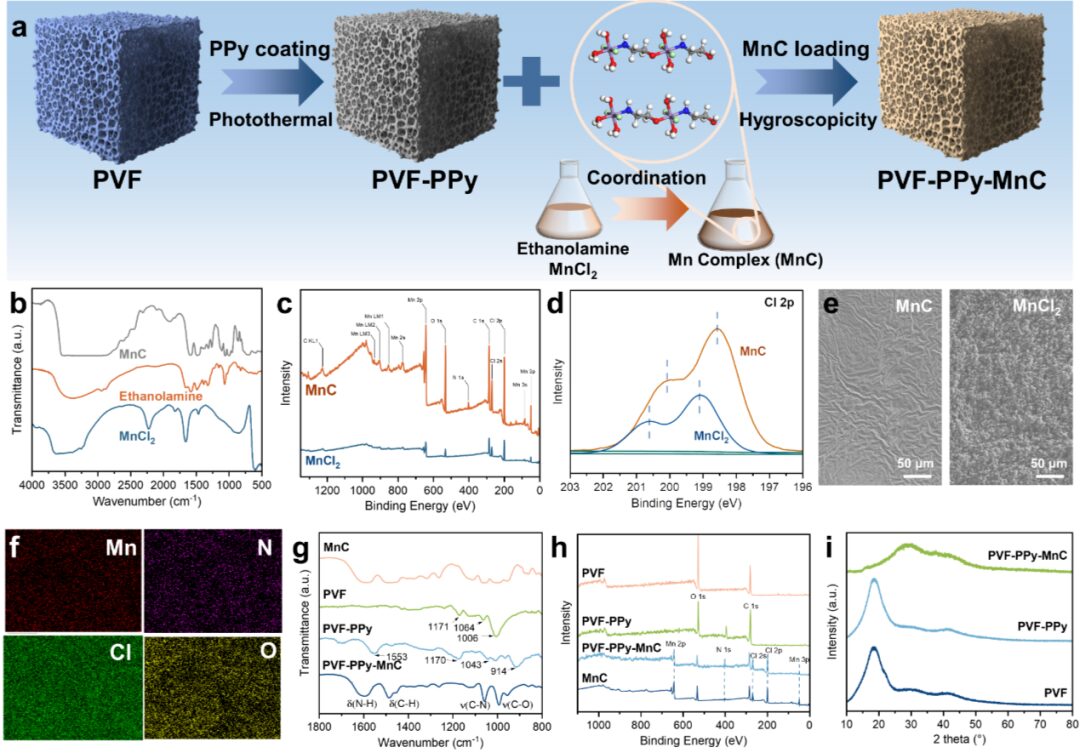 Figure 1 shows the synthesis and characterization process of the adsorption material. FTIR spectroscopy and XPS analysis confirmed the successful synthesis of MnC and its uniform distribution on the PVF matrix. The SEM images of this material show its good pore structure, which facilitates efficient moisture transfer and adsorption reactions.
【Device-Level Material Adsorption Performance and Desorption Strategy Design】
The size effect of the hygroscopic composite material at a larger scale has a long-term impact on device-level adsorption performance. Through mass transfer resistance network analysis, it was found that the internal diffusion resistance of the material is the key factor affecting overall mass transfer performance. This research effectively utilized the hierarchical pore channels present in the polyvinyl alcohol acetal foam to weaken the internal diffusion resistance of the material, ensuring that the size effect of the produced material is not significant, thus ensuring the feasibility of optimizing the material’s performance in devices using laboratory data. Additionally, utilizing the solar energy-waste heat coupled desorption mode proposed by the research team earlier, the water release performance of the enlarged material under three conditions: separate photothermal desorption, spatial heating desorption, and waste heat-solar energy coupled interface desorption was explored, providing design assurance for achieving stable performance of materials in diverse outdoor climatic environments in the future.
Figure 1 shows the synthesis and characterization process of the adsorption material. FTIR spectroscopy and XPS analysis confirmed the successful synthesis of MnC and its uniform distribution on the PVF matrix. The SEM images of this material show its good pore structure, which facilitates efficient moisture transfer and adsorption reactions.
【Device-Level Material Adsorption Performance and Desorption Strategy Design】
The size effect of the hygroscopic composite material at a larger scale has a long-term impact on device-level adsorption performance. Through mass transfer resistance network analysis, it was found that the internal diffusion resistance of the material is the key factor affecting overall mass transfer performance. This research effectively utilized the hierarchical pore channels present in the polyvinyl alcohol acetal foam to weaken the internal diffusion resistance of the material, ensuring that the size effect of the produced material is not significant, thus ensuring the feasibility of optimizing the material’s performance in devices using laboratory data. Additionally, utilizing the solar energy-waste heat coupled desorption mode proposed by the research team earlier, the water release performance of the enlarged material under three conditions: separate photothermal desorption, spatial heating desorption, and waste heat-solar energy coupled interface desorption was explored, providing design assurance for achieving stable performance of materials in diverse outdoor climatic environments in the future.
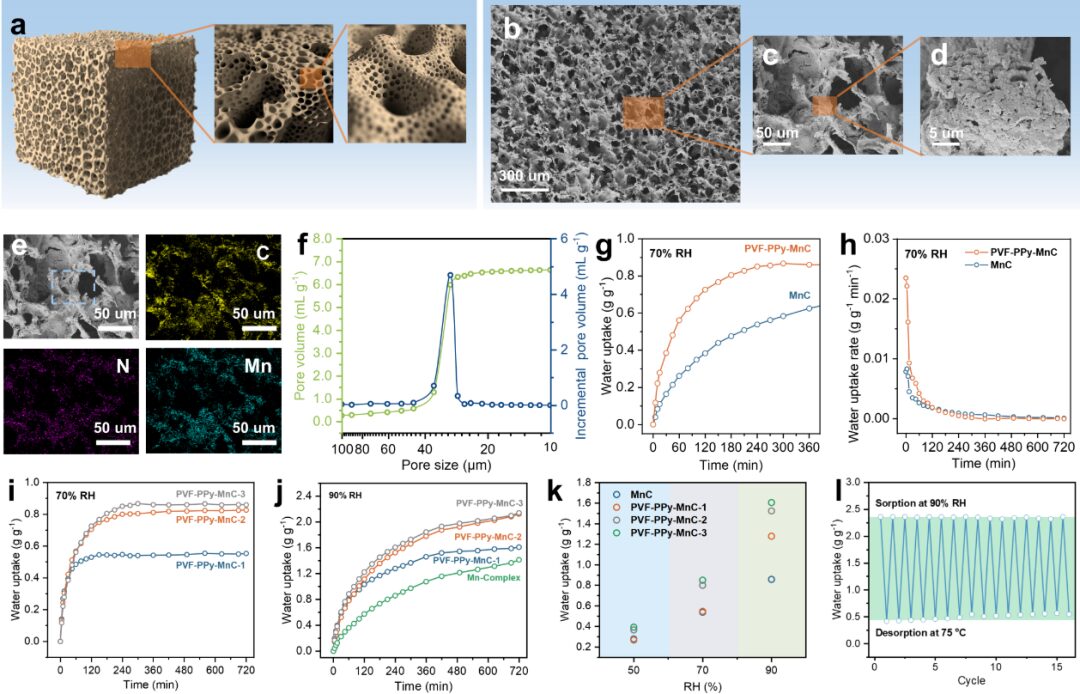 Figure 2 illustrates the optimization of the pore structure and adsorption performance of the material. The hierarchical porous structure of the PVF matrix not only enhances the photothermal desorption capability of the material but also significantly improves the adsorption efficiency by providing a large surface area. Dynamic adsorption experiments under different humidity conditions indicated that the adsorption rate of PVF-PPy-MnC at 70% relative humidity was significantly higher than that of single MnC, demonstrating a faster moisture equilibrium adsorption capability.
Figure 2 illustrates the optimization of the pore structure and adsorption performance of the material. The hierarchical porous structure of the PVF matrix not only enhances the photothermal desorption capability of the material but also significantly improves the adsorption efficiency by providing a large surface area. Dynamic adsorption experiments under different humidity conditions indicated that the adsorption rate of PVF-PPy-MnC at 70% relative humidity was significantly higher than that of single MnC, demonstrating a faster moisture equilibrium adsorption capability.
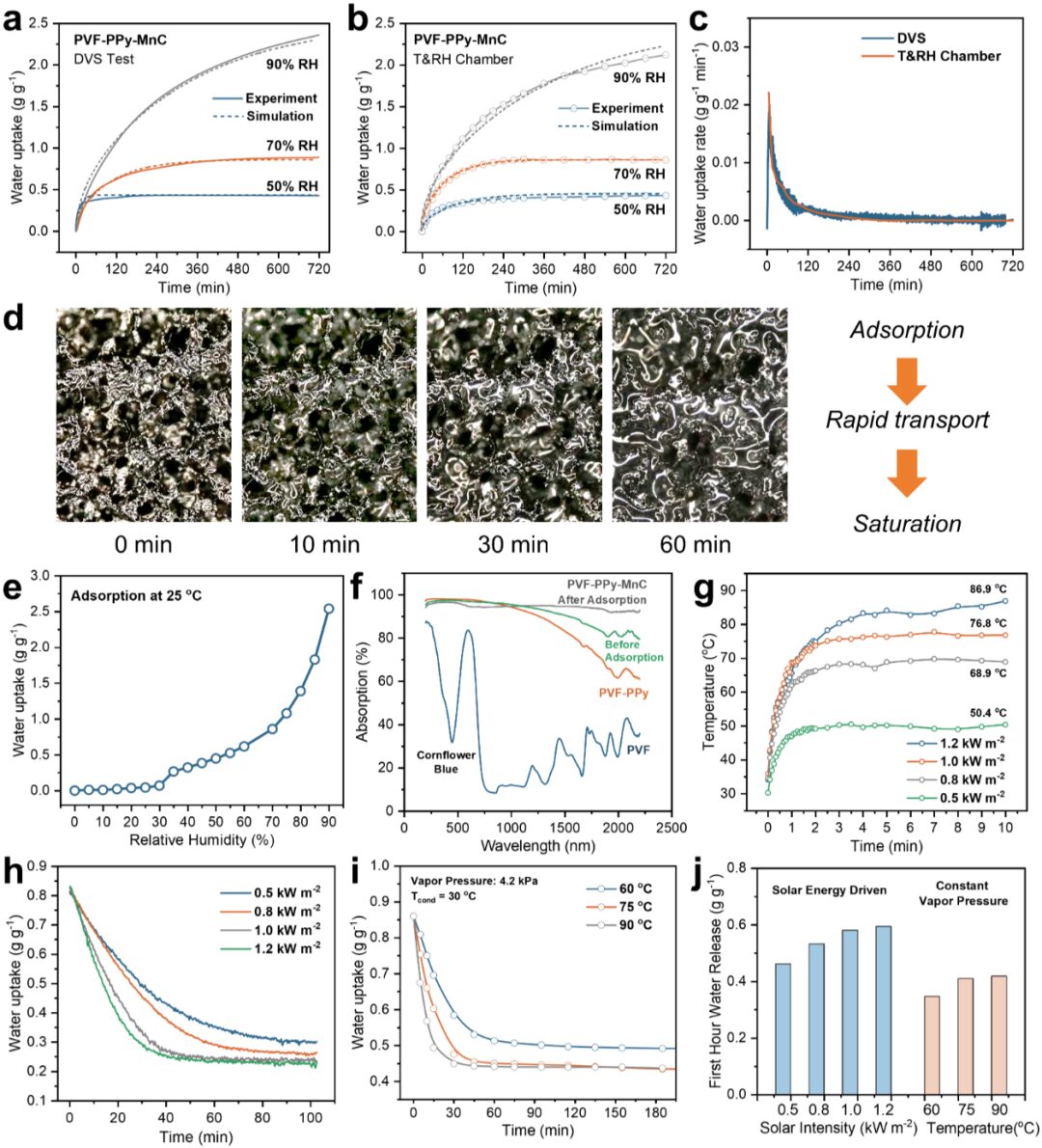 Figure 3 showcases the adsorption and desorption evaluation of milligram-level and large-scale samples. The research first tested the dynamic adsorption curves of milligram-level PVF-PPy-MnC samples at 50%, 70%, and 90% relative humidity (RH) through dynamic vapor sorption (DVS), with theoretical kinetic curves closely matching experimental data. Then, large-scale samples were tested in a constant temperature and humidity chamber, showing similar adsorption rates for both, and high-resolution optical microscopy images revealed three stages of the adsorption process: adsorption at the pore surface, diffusion, and final saturation. Water adsorption isotherm tests indicated that the material exhibits good adsorption performance at 25°C, and UV-Vis-NIR spectroscopy showed a significant enhancement in light absorption after doping with PPy. The temperature rise curve and dynamic water release curve further validated the material’s performance under different light intensities. Finally, the dynamic desorption curve demonstrated the amount of desorption of the material under different temperatures and constant vapor pressure conditions, indicating that the material has a high desorption efficiency within the first hour.
【Field Operation Demonstration】
This research demonstrated the outdoor fully automated atmospheric water source irrigation rooftop farm that was built. The device is powered by solar photovoltaic panels and batteries, utilizing an Arduino Nano microcontroller and motors to switch between unattended water release and capture modes, with an automatic control system set to precisely regulate the adsorption and desorption durations. These systems ensured efficient and stable moisture acquisition during a 14-day long unattended outdoor experiment, ultimately achieving a water yield of 879.9 grams per square meter and a food yield of 1.28 kilograms per square meter within 14 days, proving the feasibility of the technological coupling.
Figure 3 showcases the adsorption and desorption evaluation of milligram-level and large-scale samples. The research first tested the dynamic adsorption curves of milligram-level PVF-PPy-MnC samples at 50%, 70%, and 90% relative humidity (RH) through dynamic vapor sorption (DVS), with theoretical kinetic curves closely matching experimental data. Then, large-scale samples were tested in a constant temperature and humidity chamber, showing similar adsorption rates for both, and high-resolution optical microscopy images revealed three stages of the adsorption process: adsorption at the pore surface, diffusion, and final saturation. Water adsorption isotherm tests indicated that the material exhibits good adsorption performance at 25°C, and UV-Vis-NIR spectroscopy showed a significant enhancement in light absorption after doping with PPy. The temperature rise curve and dynamic water release curve further validated the material’s performance under different light intensities. Finally, the dynamic desorption curve demonstrated the amount of desorption of the material under different temperatures and constant vapor pressure conditions, indicating that the material has a high desorption efficiency within the first hour.
【Field Operation Demonstration】
This research demonstrated the outdoor fully automated atmospheric water source irrigation rooftop farm that was built. The device is powered by solar photovoltaic panels and batteries, utilizing an Arduino Nano microcontroller and motors to switch between unattended water release and capture modes, with an automatic control system set to precisely regulate the adsorption and desorption durations. These systems ensured efficient and stable moisture acquisition during a 14-day long unattended outdoor experiment, ultimately achieving a water yield of 879.9 grams per square meter and a food yield of 1.28 kilograms per square meter within 14 days, proving the feasibility of the technological coupling.
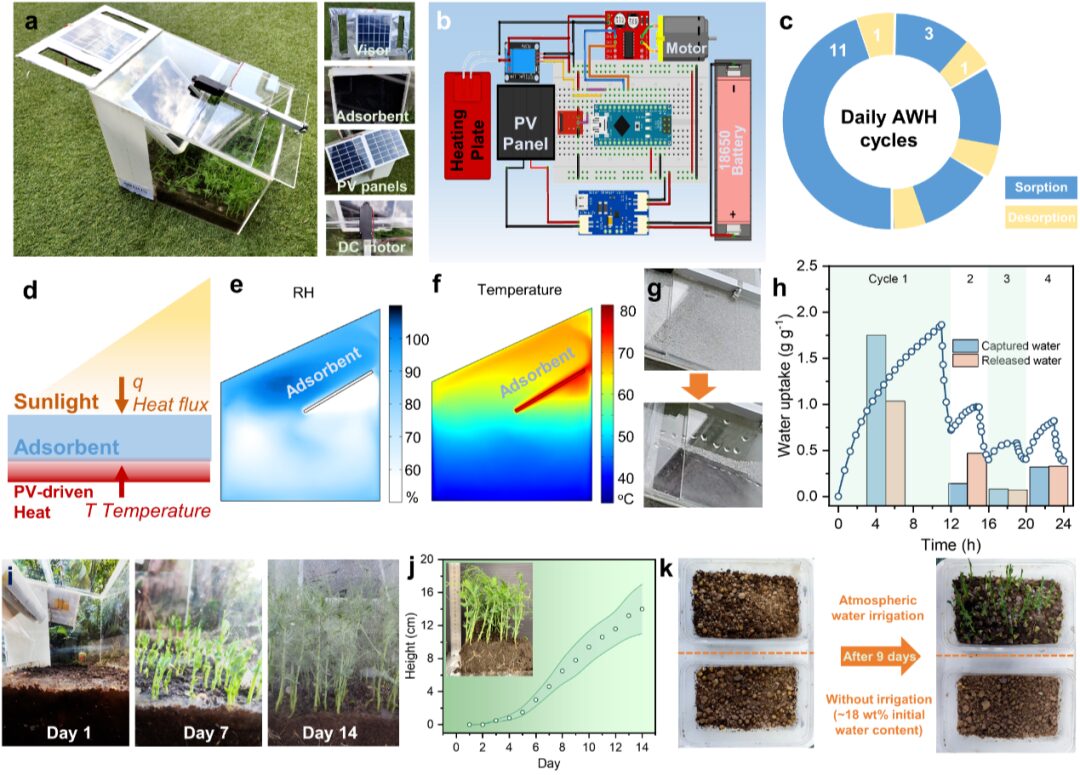 Figure 4 shows the outdoor demonstration of the AWH irrigation rooftop farm. The research team installed the AWH irrigation rooftop farm device on an actual building rooftop and conducted a 14-day outdoor experiment. The device is powered by solar photovoltaic panels and batteries, ensuring the system operates stably under all weather conditions.
【Discussion: From Laboratory to Real-World Application, Towards Urban Sustainable Development】
This research aims to bridge the gap between laboratory material development and device construction. In the material development process, not only were the optimized performance results from the laboratory reported, but also the results of large-scale synthesis and testing in real environments were demonstrated. At the device level, the impact of heat and mass transfer on the entire device was considered, and the temperature variations affecting water collection were assessed. However, it should be noted that this is only a small step; due to conditions, the verification area of the adsorption materials and rooftop farms is still less than 1 square meter, and the scalability and cost-effectiveness of materials and devices still need further validation. Issues that need to be addressed during the scaling process include designing devices from a scalability perspective to improve thermodynamic efficiency and space utilization. Additionally, optimizing the adsorption-desorption cycle time in real environments is more important than relying solely on laboratory data for decision-making.
Combining atmospheric water harvesting technology with rooftop agriculture provides unprecedented opportunities for sustainable urban development. Beyond the apparent benefits of water and food production, this technology can further integrate with the unique characteristics of existing buildings. By utilizing the waste heat generated by the building’s HVAC systems as the energy needed for desorption, it recovers resources that are typically wasted, avoiding negative impacts on plant growth while maximizing thermal energy utilization and regulating indoor temperature and humidity. Furthermore, rooftop farms can alleviate the thermal load of buildings by providing shade and transpiration, reducing energy consumption and mitigating the impact of urban heat island effects on local climate and environment. Ultimately, this localized sustainable method of water and food acquisition eliminates the need for long-distance transportation, further revolutionizing our understanding of water resource and food production in urban sustainability. We have taken a key step towards achieving sustainable urban development at the intersection of energy, water, and food, addressing global food security and supply challenges.
First Author – Shan Xuan Joint PhD student at Shanghai Jiao Tong University and the National University of Singapore, under the supervision of Professor Wang Ruzhu and co-supervised by Professor Tan Swee Ching. Research focus on composite adsorption materials for interdisciplinary studies involving air-energy-water, with an emphasis on the development of hygroscopic gels and optimization of atmospheric water harvesting device cycling strategies.
Figure 4 shows the outdoor demonstration of the AWH irrigation rooftop farm. The research team installed the AWH irrigation rooftop farm device on an actual building rooftop and conducted a 14-day outdoor experiment. The device is powered by solar photovoltaic panels and batteries, ensuring the system operates stably under all weather conditions.
【Discussion: From Laboratory to Real-World Application, Towards Urban Sustainable Development】
This research aims to bridge the gap between laboratory material development and device construction. In the material development process, not only were the optimized performance results from the laboratory reported, but also the results of large-scale synthesis and testing in real environments were demonstrated. At the device level, the impact of heat and mass transfer on the entire device was considered, and the temperature variations affecting water collection were assessed. However, it should be noted that this is only a small step; due to conditions, the verification area of the adsorption materials and rooftop farms is still less than 1 square meter, and the scalability and cost-effectiveness of materials and devices still need further validation. Issues that need to be addressed during the scaling process include designing devices from a scalability perspective to improve thermodynamic efficiency and space utilization. Additionally, optimizing the adsorption-desorption cycle time in real environments is more important than relying solely on laboratory data for decision-making.
Combining atmospheric water harvesting technology with rooftop agriculture provides unprecedented opportunities for sustainable urban development. Beyond the apparent benefits of water and food production, this technology can further integrate with the unique characteristics of existing buildings. By utilizing the waste heat generated by the building’s HVAC systems as the energy needed for desorption, it recovers resources that are typically wasted, avoiding negative impacts on plant growth while maximizing thermal energy utilization and regulating indoor temperature and humidity. Furthermore, rooftop farms can alleviate the thermal load of buildings by providing shade and transpiration, reducing energy consumption and mitigating the impact of urban heat island effects on local climate and environment. Ultimately, this localized sustainable method of water and food acquisition eliminates the need for long-distance transportation, further revolutionizing our understanding of water resource and food production in urban sustainability. We have taken a key step towards achieving sustainable urban development at the intersection of energy, water, and food, addressing global food security and supply challenges.
First Author – Shan Xuan Joint PhD student at Shanghai Jiao Tong University and the National University of Singapore, under the supervision of Professor Wang Ruzhu and co-supervised by Professor Tan Swee Ching. Research focus on composite adsorption materials for interdisciplinary studies involving air-energy-water, with an emphasis on the development of hygroscopic gels and optimization of atmospheric water harvesting device cycling strategies.
 Corresponding Author – Professor Wang RuzhuEngaged in research on refrigeration, heat pumps, and thermal and humidity control. The results of his work have won the National Natural Science Second Prize and the National Technology Invention Second Prize, as well as the He Liang He Li Foundation Science and Technology Innovation Award; he has received numerous important international academic awards including the Global Energy Prize, the International Energy Agency Heat Pump Award, and the Gustav Lorentzen Medal from the International Institute of Refrigeration. He leads the Energy-Water-Air Innovation Team (ITEWA), which has long been dedicated to solving cutting-edge fundamental scientific problems and key technologies in the interdisciplinary fields of energy, water, and air, aiming to achieve holistic solutions at the material-device-system level through interdisciplinary collaboration, promoting breakthrough progress in related fields. The team has published over 40 interdisciplinary papers in high-level journals such as Science, Nature Water, Joule, EES, Advanced Materials, and Nature Communications in the past five years.
Corresponding Author – Professor Wang RuzhuEngaged in research on refrigeration, heat pumps, and thermal and humidity control. The results of his work have won the National Natural Science Second Prize and the National Technology Invention Second Prize, as well as the He Liang He Li Foundation Science and Technology Innovation Award; he has received numerous important international academic awards including the Global Energy Prize, the International Energy Agency Heat Pump Award, and the Gustav Lorentzen Medal from the International Institute of Refrigeration. He leads the Energy-Water-Air Innovation Team (ITEWA), which has long been dedicated to solving cutting-edge fundamental scientific problems and key technologies in the interdisciplinary fields of energy, water, and air, aiming to achieve holistic solutions at the material-device-system level through interdisciplinary collaboration, promoting breakthrough progress in related fields. The team has published over 40 interdisciplinary papers in high-level journals such as Science, Nature Water, Joule, EES, Advanced Materials, and Nature Communications in the past five years.
 Corresponding Author – Professor Tan Swee ChingObtained a PhD in Electrical Engineering from the University of Cambridge and subsequently conducted postdoctoral research in the Department of Materials Science and Engineering at the Massachusetts Institute of Technology. He is currently an associate professor in the Department of Materials Science and Engineering at the National University of Singapore. He previously worked at HP as a laser processing and equipment engineer, helping the company reduce annual operating costs by at least $400,000 and increasing productivity by 35%, for which he was awarded the HP Outstanding Achievement Award. He is also the founder of Ultra Dry, a company focused on super hygroscopic materials. Dr. Tan has published numerous excellent papers in top international journals such as Nature Electronics, Nature Sustainability, Joule, EES, Advanced Materials, Nature Communications, and Science Advances.
https://onlinelibrary.wiley.com/doi/10.1002/adfm.202402839
Corresponding Author – Professor Tan Swee ChingObtained a PhD in Electrical Engineering from the University of Cambridge and subsequently conducted postdoctoral research in the Department of Materials Science and Engineering at the Massachusetts Institute of Technology. He is currently an associate professor in the Department of Materials Science and Engineering at the National University of Singapore. He previously worked at HP as a laser processing and equipment engineer, helping the company reduce annual operating costs by at least $400,000 and increasing productivity by 35%, for which he was awarded the HP Outstanding Achievement Award. He is also the founder of Ultra Dry, a company focused on super hygroscopic materials. Dr. Tan has published numerous excellent papers in top international journals such as Nature Electronics, Nature Sustainability, Joule, EES, Advanced Materials, Nature Communications, and Science Advances.
https://onlinelibrary.wiley.com/doi/10.1002/adfm.202402839





